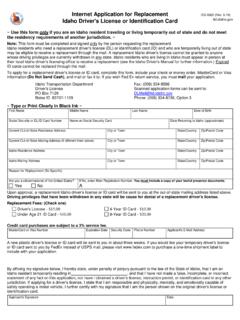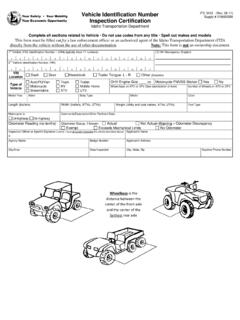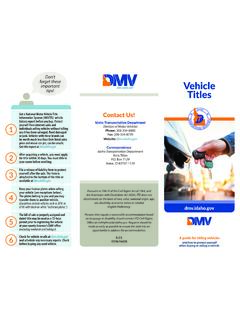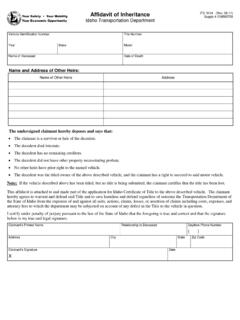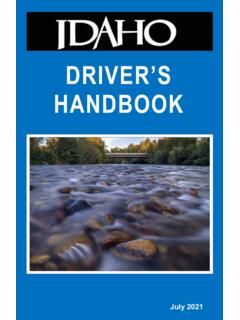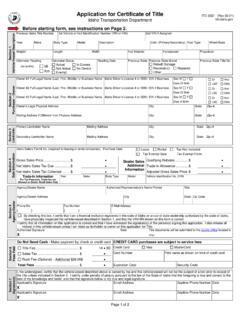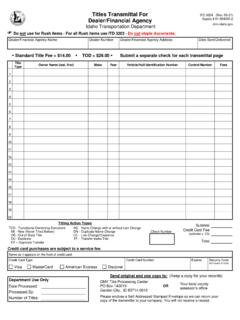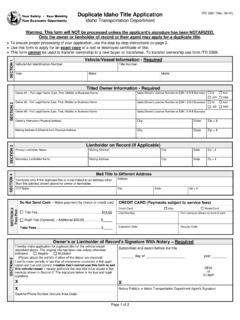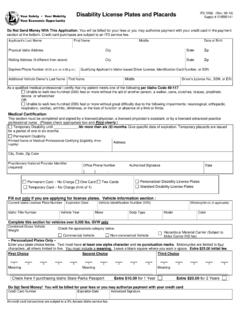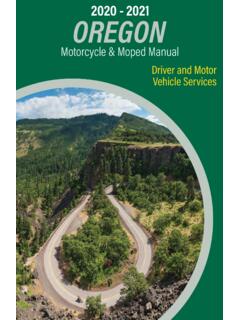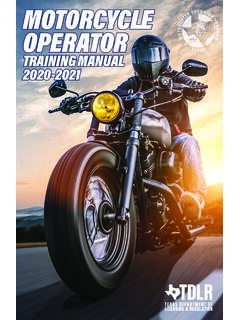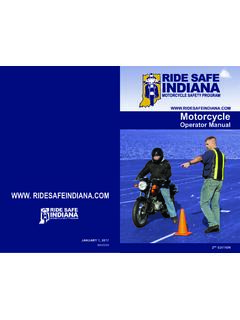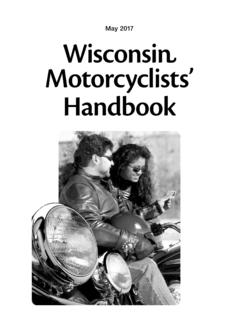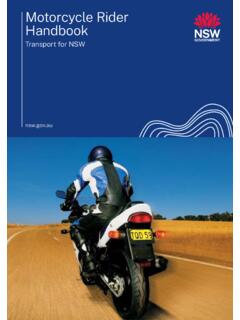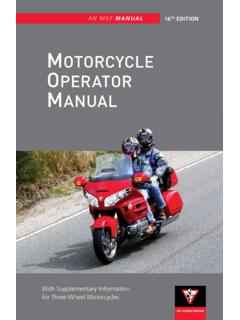Transcription of MOTORCYCLE RIDER’S
1 MOTORCYCLE RIDER'S. HANDBOOK. IN- SERT. PHO- TO. HERE. July 2021. The Idaho MOTORCYCLE Rider's Manual paraphrases the language of Idaho Statues. Courts go by the actual language of the statues, not this text. The Idaho Transportation Department (ITD) is committed to compliance with Title VI of the Civil Rights Act of 1964 and all related regulations and directives. ITD assures that no person shall on the grounds of race, color, national origin, gender, age, or disability be excluded from participation in, be denied the benefits of, or be otherwise subjected to discrimination under any ITD service, program, or activity. The department also assures that every effort will be made to prevent discrimination through the impacts of its Programs, policies, and activities on minority and low-income populations. In addition, the department will take reasonable steps to provide meaningful access to services for persons with limited English proficiency.
2 2. PREFACE. Riding a MOTORCYCLE can be safe and fun when the rider be- comes more knowledgeable and skilled. This manual, even though designed mostly for the novice rider, can educate all MOTORCYCLE riders about safe riding habits and strategies to recognize and avoid or safely manage potential rid- ing hazards to avoid accidents. The Idaho Transportation Department used information provided by the MOTORCYCLE Safety Foundation (MSF). and Idaho STAR to compile the Idaho MOTORCYCLE Rider's Manu- al, knowledge and skills tests. Enhanced licensing requirements along with quality MOTORCYCLE rider education and increased public awareness have the poten- tial to reduce the number and severity of motor- cycle crashes. 3. TABLE OF CONTENTS. MOTORCYCLE ENDORSEMENT REQUIREMENT. Definitions & Requirements .. 9. APPLYING FOR A MOTORCYCLE ENDORSEMENT. Riding Requirements.
3 16. Instruction Permit .. 16. Knowledge 17. Skills Test .. 17. Fees .. 17. PREPARING TO RIDE. Riding Environment .. 18. Riding Gear .. 19. Helmet 19. Helmet Selection .. 20. Eye & Face Protection .. 21. Clothing .. 22. Exposed or Protected .. 23. Know the MOTORCYCLE .. 24. The Right MOTORCYCLE for You .. 24. Required Equipment .. 24. Becoming Familiar with the 27. Checking the MOTORCYCLE .. 27. Borrowing & Lending .. 29. Know Your Responsibilities .. 29. RIDER ABILITIES. Basic Vehicle Control .. 31. Body Position .. 31. Getting Underway .. 32. Braking .. 34. Stopping in a Curve .. 35. Linked & Integrated Braking Systems .. 36. Anti-Lock Braking Systems (ABS) .. 36. Turning .. 36. Keeping Distance .. 38. Lane 38. Following Another Vehicle .. 40. 4. Being Followed .. 41. Passing & Being Passed .. 42. Passing Parked Vehicles .. 43. Parking .. 44. Lane Filtering/Splitting/Sharing.
4 45. Merging Vehicles .. 46. Vehicles Alongside .. 46. Mental Motorcycling ( ).. 47. Scan .. 47. 47. Predict .. 48. Decide .. 48. Execute .. 49. Intersections .. 50. Blind Intersections .. 50. Stop Signs & Signals .. 50. Traffic Control Signals .. 51. See & Be 52. Clothing .. 52. Headlight .. 53. Signals .. 53. Brake Light .. 54. Mirrors .. 54. Head Checks .. 55. Horn .. 55. Riding at Night .. 56. Crash Avoidance .. 56. Quick Stops .. 57. Front Wheel Skids .. 58. Rear Wheel Skids .. 58. Swerving or Turning Quickly .. 58. Cornering & Curves .. 60. Hazardous Riding Conditions .. 61. Obstacles on the Highway .. 62. Slippery & Loose Surfaces .. 63. Rippled & Uneven Pavement Edges .. 64. Wind .. 64. Crowned Pavement .. 65. Animals .. 65. Flying 66. Railroad & Trolley Tracks .. 66. Grooves & Bridge Gratings .. 67. Mechanical Problems .. 67. Tire Failure .. 67. 5. Stuck Throttle.
5 68. Wobble .. 68. Drive Train Problems .. 69. Engine 69. Getting Off the Highway .. 69. Carrying Passengers & Cargo .. 70. Required Equipment .. 70. Instructing 71. Riding with 72. Carrying 72. Group Riding .. 73. Keeping the Group Small .. 73. Keeping the Group Together .. 73. Keeping Adequate Distance Between motorcycles .. 74. RIDER RISKS & RESPONSIBILTIES 76. Important .. 76. Alcohol & Drugs While Riding .. 76. Alcohol in the Body .. 77. Blood Alcohol Concentration (BAC) .. 77. Alcohol & Idaho Law .. 79. Penalties when Completing & Failing a Breath Test .. 79. Alcohol Test Refusal .. 80. Administrative License 80. Minimize the Risks .. 81. Making an Intelligent Choice .. 81. Step In & Protecting Fellow 81. Fatigue .. 82. TWO-WHEEL MOTORCYCLE SKILLS 83. THREE-WHEEL MOTORCYCLE SUPPLEMENT ..88. Knowing the MOTORCYCLE .. 88. Three-wheel MOTORCYCLE Designs.
6 89. The Right MOTORCYCLE for 90. Borrowing & 90. Becoming Familiar with MOTORCYCLE Controls ..90. THREE-WHEEL MOTORCYCLE SUPPLEMENT .. 92. Carrying Passengers & Cargo .. 97. 6. THREE-WHEEL MOTORCYCLE SKILLS TEST ..99. MOTORCYCLE HAND SIGNALS .. 103. MOTORCYCLE SKILLS TEST CHECK LIST .. 104. MOTORCYCLE PRACTICE KNOWLEDGE TEST .. 105. PROFESSIONAL TRAINING .. 107. SMART RIDER COMMITMENTS .. 110. 7. FEES. MOTORCYCLE riders will be required to pay one or more of the following fees in addition to the cost of the regular driver's license: MOTORCYCLE M Endorsement: $ (one-time fee). MOTORCYCLE Instruction Permit: $ (valid for 180 days). MOTORCYCLE Skills Test: $ (paid to examiner). MOTORCYCLE Knowledge Test: $ (paid to the county). 8. MOTORCYCLE ENDORSEMENT. REQUIREMENTS. Motorized vehicles driven on public highways require a valid driver's license and proof of liability insurance.
7 Certain motorcycles ridden on public highways also require a MOTORCYCLE endorsement on the driver's license. The following information can be used to determine if the vehicle being ridden is a MOTORCYCLE , motor-driven cycle or motorbike that requires a MOTORCYCLE endorsement on the driver's license. DEFINITIONS AND REQUIREMENTS. MOTORCYCLE [49-114(11)] MOTORCYCLE means every motor vehicle having a seat or saddle for the use of the rider and designed to travel on not more than three wheels in contact with the ground, or two wheels in contact with the ground which is modified by the addition of two stabilizing wheels on the rear of the MOTORCYCLE , that meets the federal motor vehicle safety standards (FMVSS) as originally designed, and includes a converted motorbike, but does not include a motor-driven cycle, a motorbike, a tractor or a moped. motorcycles require a MOTORCYCLE endorsement.
8 (See requirements on page 10). Motor-Driven Cycle [49-114(13)] Motor-driven cycle means a cycle with a motor that produces 5 brake horsepower or less as originally manufactured that meets federal motor vehicle safety standards as originally designed, and does not include mopeds. Such vehicles shall be titled and have a MOTORCYCLE endorsement. (See requirements on page 11). Motor Scooter and Scooter A motor scooter is a light, 2- wheeled cycle designed with the driver's seat over an enclosed engine and with an open, step through frame and a floorboard for the driver's feet to rest. It is treated as a MOTORCYCLE or motor-driven cycle when meeting FMVSS. If it has this design but does not meet FMVSS, it can be considered a moped or motorbike if it meets the definition or it may otherwise be regarded as a motorized toy. (See requirements on page 12). 9. Motor Bike - For a motorbike > 50 cc's ( designed for or capa- ble of traveling off developed highways; doesn't meet ).
9 Or a motorbike < 50 cc's ( designed for or capable of traveling off developed highways; doesn't meet ) see number 3 un- der footnotes to determine if a MOTORCYCLE endorsement is re- quired or not. Code 49-114 (9)(2) qualifies that any scooter or mo- torcycle (regardless of cc size) that can travel in ex- cess of 30mph is not a moped and thus considered a MOTORCYCLE . 10. VEHICLE TYPE MOTORCYCLE (Either internal combustion or electric motor meets ). REGISTRATION/ Regular highway/plates; or restricted vehicle regis- PLATES tration/plates; or Off-highway vehicle (OHV) regis- tration sticker only. OPERATION IS With regular highway registration/plates: All high- ALLOWED ways including state, and interstate, etc., ex- cept roads that require OHV registration sticker. With restricted vehicle registration/plates: 1) coun- ty, city and highway district roads not closed to OHV use, and non-full-access controlled state high- ways within city limits and within one mile of city limits with a speed limit of 45 mph or less open to OHV use (check with local jurisdiction for roads closed to OHV use); and 2) Idaho Dept.
10 Of Land, BLM, Forest Service, and private roads open to OHV use (contact the land owner or manager for information on roads open to OHV use), and off-highway on a designated trail, open riding area, or motocross track 2. With OHV registration sticker: (see #2 listed above.). WHAT IS REQUIRED? DRIVER'S MOTORCYCLE . TITLE INSURANCE. LICENSE ENDORSEMENT.. 11. VEHICLE TYPE Motor-driven cycle (Either internal combustion mo- tor, < 5 hp or electric < 3,729 watts and meets Includes dual-sport.). REGISTRATION/ Regular highway/plates; or restricted vehicle PLATES registration/plates; or Off-highway vehicle (OHV). registration sticker only. OPERATION IS With regular highway registration/plates: ALLOWED All highways including state, and interstate, etc., except roads that require an OHV registration sticker. With restricted vehicle registration/plates: 1) county, city and highway district roads not closed to OHV use, and non-full-access controlled state highways within city limits and within one mile of city limits with a speed limit of 45 mph or less open to OHV use (check with local jurisdiction for roads closed to OHV use); and 2) Idaho Dept.

